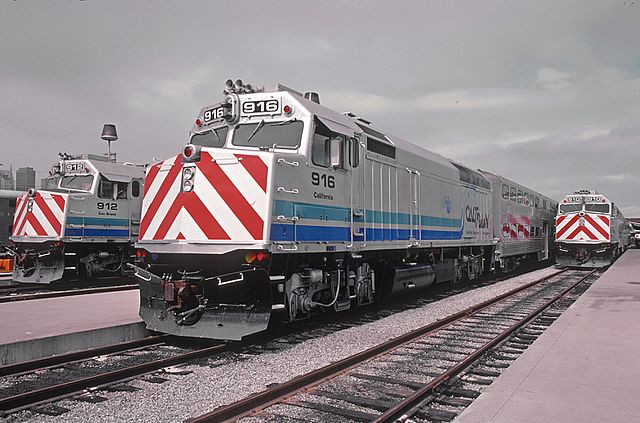In 1978, when I moved from Maryland to California (now my permanent home), there were only a smattering of railroads across the U.S. that served the commuting public. Caltrain – before it was called “Caltrain” (providing such service between San Francisco – also known as the City by the Bay – and San Jose – located 47.5 railroad miles away), was one of those.
Caltrain, furthermore, has built a solid reputation in its role as passenger-train-service provider.
Over the years, Caltrain’s equipment (rolling stock), physical plant (infrastructure) and route have all been updated, like when service was extended to Gilroy located 30 miles to San Jose’s south or with its program involving grade separations (such designed to keep motor vehicle and/or bicycle and/or pedestrian and railway traffic separated and therefore eliminate the possibility of the rail- and pavement-based modes from ever directly crossing paths with one another). Eliminating railroad crossings, incidentally, cannot only help in preventing collisions between pavement- and rail-based modes, but is also foundational in improving the quality of local air.
Talk about the railroad changing its profile, that’s just the half of it.
Consider now Caltrain’s work being done to install on nearly 50 miles of right-of-way catenary supported electrical hardware, infrastructure necessary for delivering the “juice” (energy supply) needed to power its electric trains (some on property already, the rest still to be received – and previously covered in “America riding a passenger-rail-revival wave”), this activity a part of the concern’s ongoing modernization program that includes the acquisition and utilization of what is known as “BEMU” or “battery-equipped electric multiple unit” trainsets that will provide service between San Jose and Gilroy in non-electrified- or conventional-track territory, these conveyances ultimately displacing and retiring 100 percent of the diesel-powered equipment that is currently used to convey passengers about the property.

Caltrain, in an Aug. 18, 2023 press statement, further explained: “The BEMU train, which will be purchased on a contract option with Stadler, Caltrain’s electric train manufacturer, is an EMU train with additional energy storage capacity. The BEMU will charge while the train runs on overhead power in the electrified service areas and then use battery charge to travel ‘off-wire’ on non-electrified track areas. This will lead the way for Caltrain to operate a fully zero-emission service in the future. Before this option, Caltrain would have had to use diesel trains on the non-electrified corridor. The funding award from CalSTA [California State Transportation Agency] also covers the cost of testing at the Transportation Test Center in Pueblo, Colo., and upgrades to the San Jose Central Maintenance Facility and Gilroy layover and station area to facilitate charging and maintenance.
“The demonstration of the BEMU in-service will be the first time this bi-level technology is in operation on a commuter train anywhere in the United States. The trainset is also expected to be tested in other intercity and regional rail corridors, as feasible.”
All of which to me means that this one trial, could indeed pave the way for more such rail-commuter-service providers to follow suit.
Historical profile
Caltrain continues a service and tradition that was first begun on Jan. 16, 1864. It is a public-transit provision that has stood the test of time.
The operation began life as the San Francisco & San Jose Railroad. The 47.5 mile-long system was taken over by the now defunct Southern Pacific Railroad in 1870. Originally, trains were steam-locomotive hauled. This practice lasted until 1956 when responsibility for that job became that of the diesel-electric engine’s alone.
As to the trains themselves, seen for quite a time rolling up and down the Peninsula line were strings of what are referred to as Harriman-era coaches, perhaps SP’s most recognizable peninsula-commute passenger cars of all time. The trains operated over the territory all the way up to and including the 1980s.
The story of how or why Caltrain came to be, meanwhile, goes as follows:
“After questioning its role as a passenger train service provider, SP handed management of the system over to the State of California in 1980 while SP was retained as operator of the trains. On July 1, 1992, the Peninsula Corridor Joint Powers Board took on full responsibility for the CalTrain operation,” I wrote in the Winter 1996 (Volume 5, No. 1) “California Lifesaver” newsletter edition.
It should be noted that I’ve never ridden any of the trains themselves; however, because of where I lived and worked when I resided in the Bay Area (in Mountain View and Sunnyvale, respectively) in the late 1970s, I would frequently encounter the trains.
May the legacies of the San Francisco & San Jose Railroad and successor Southern Pacific Transportation Company be everlasting!
Last updated on Aug. 20, 2023 at 7:40 a.m. Pacific Daylight Time.
Above images: Peninsula Corridor Joint Powers Board (upper); Roger Puta (lower)
⁃ Alan Kandel
Copyrighted material.
Corresponding, connected home-page-featured image: Peninsula Corridor Joint Powers Board
